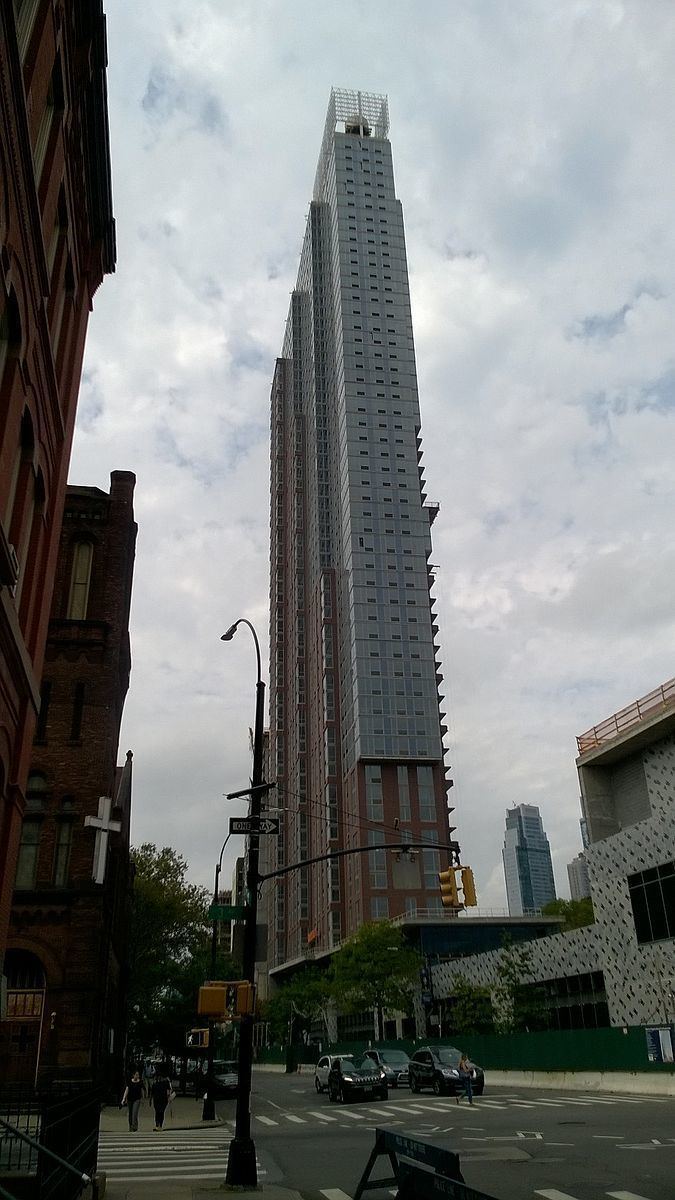 | ||
Brooklyn (pronounced /ˈbrʊklɪn/), the most populous of New York City's five boroughs, contains over 40 high-rises that stand taller than 295 feet (90 m). The Hub, an apartment rental tower in Downtown Brooklyn, is Brooklyn's tallest building at 610 feet (186 m). The Williamsburgh Savings Bank Tower in Fort Greene, at 512 feet (156 m), was the tallest building in Brooklyn for 80 years from its completion in 1929 until 2009, when The Brooklyner was topped out at 514 feet (157 m).
Contents
History
The construction of high-rise buildings in Brooklyn began during the late 19th century, following the completion of the Brooklyn Bridge in 1883 and the building of elevated railroads and streetcar lines during the late 1880s. Increased accessibility to Downtown Brooklyn brought greater economic growth and propagated denser commercial development, which increased the heights of downtown buildings throughout the 1890s. This led to the 1891 construction of Brooklyn's first skyscraper, the 10-story Franklin Trust Company Building. By 1901, the 13-story Temple Bar Building was completed and was the borough's first steel-beam high-rise, its largest office building, and its tallest at 164 feet (50 m). In the early 20th-century, the opening of multiple New York City Subway lines in Downtown Brooklyn spurred further development of tall commercial buildings. The Zoning Resolution of 1916, which required buildings to incorporate setbacks from the street to allow for sunlight, influenced the construction of taller, more slender buildings.
In 1918, the 22-story and 220-foot (67 m) building at 32 Court Street was completed and regarded as Brooklyn's first "true skyscraper", and thus initiated a skyscraper building boom in Brooklyn centered on Court and Montague Streets. Brooklyn's high-rise development continued unabated into the 1920s. The Court and Remsen Building, built in 1926 at 350 feet (107 m) in height, was the first of the major high-rises to be built in Brooklyn during the 1920s and briefly held the title of Brooklyn's tallest building until 1927, when the Montague-Court Building was completed and became Brooklyn's tallest building at 462 feet (141 m). Brooklyn's skyscraper building boom ceased during the Great Depression, and the Williamsburgh Savings Bank Tower in Fort Greene, which was completed in 1929, remained Brooklyn's tallest building until 2009.
In 2004, several portions of Downtown Brooklyn were rezoned to promote more commercial, residential, and retail development. This rezoning allowed for greater density of development, and combined with an increased demand for housing, these areas experienced a boom in the construction of tall buildings. In addition to Downtown Brooklyn, high-rise buildings are also concentrated in the Fort Greene and Williamsburg neighborhoods, although other Brooklyn neighborhoods have significant numbers of high-rises.
Tallest buildings
There are over 40 completed or topped out skyscrapers in Brooklyn that stand at least 295 feet (90 m) tall, based on standard height measurement which includes spires and architectural details but does not include antenna masts. An equal sign (=) following a rank indicates the same height between two or more buildings. An asterisk (*) indicates that the building is still under construction, but has been topped out. The "Year" column indicates the year in which a building was completed.
Under construction
There are a number of buildings under construction in Brooklyn that are expected to rise at least 295 feet (90 m) in height. The Hub, currently under construction in Downtown Brooklyn, has become Brooklyn's tallest high-rise building at 610 feet (186 m) following its topping out in 2015.
